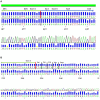Novel Variants of ANO5 in Two Patients With Limb Girdle Muscular Dystrophy: Case Report
- PMID: 35463132
- PMCID: PMC9033199
- DOI: 10.3389/fneur.2022.868655
Novel Variants of ANO5 in Two Patients With Limb Girdle Muscular Dystrophy: Case Report
Abstract
Here we report on two unrelated adult patients presenting with Limb girdle muscular dystrophy who were found to have novel variants in ANO5. Both patients had prominent weakness of their proximal lower limbs with mild weakness of elbow flexion and markedly elevated creatine kinase. Next generation sequencing using a custom-designed neuromuscular panel was performed in both patients. In one patient, 336 genes were targeted for casual variants and in the other patient (using a later panel design), 464 genes were targeted. One patient was homozygous for a novel splice variant [c.294+5G>A; p.(Ala98Ins4*)] in ANO5. Another patient was compound heterozygous for two variants in ANO5; a common frameshift variant [c.191dupA; p.(Asn64fs)] and a novel missense variant [c.952G>C; p.(Ala318Pro)]. These findings support the utility of next generation sequencing in the diagnosis of patients presenting with a Limb girdle muscular dystrophy phenotype and extends the genotypic spectrum of ANO5 disease.
Keywords: ANO5; case report; limb girdle muscular dystrophy; next generation sequencing; novel variant.
Copyright © 2022 Katz, Garton, Davis, Henderson and McCombe.
Conflict of interest statement
The authors declare that the research was conducted in the absence of any commercial or financial relationships that could be construed as a potential conflict of interest.
Figures


References
Publication types
LinkOut - more resources
Full Text Sources

